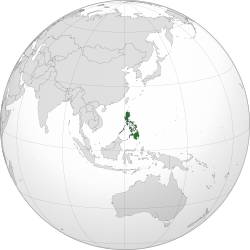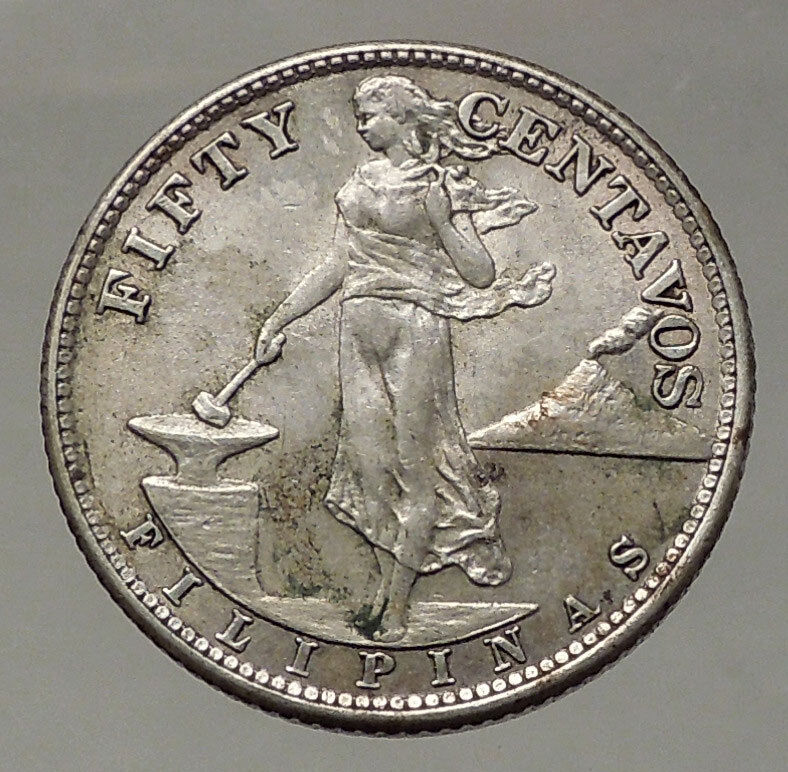|
Philippines
Emilio Aguinaldo
1975 Proof Silver 25 Piso 38mm (24.72 grams) 0.500 Silver (0.7475 oz. ASW)
Reference: KM# 211, Schön# 50
ANG BAGONG LIPUNAN REPUBLIKA NG PILIPINAS *25 PISO*, Coat-of-Arms.
REPUBLIKA NG PILIPINAS EMILIO AGUINALDO *1975*, Head of Emilio Aguinaldo 1/2 right.
You are bidding on the exact item pictured, provided with a Certificate of Authenticity and Lifetime Guarantee of Authenticity.
.jpg/220px-Emilio_Aguinaldo_ca._1919_(Restored).jpg) Emilio Aguinaldo y Famy (March 22, 1869 – February 6, 1964) was a Filipino revolutionary, statesman, and military leader who is officially recognized as the first and the youngest president of the Philippines (1899–1901) and the first president of a constitutional republic in Asia. He led Philippine forces first against Spain in the Philippine Revolution (1896–1898), then in the Spanish–American War (1898), and finally against the United States during the Philippine–American War (1899–1901). Emilio Aguinaldo y Famy (March 22, 1869 – February 6, 1964) was a Filipino revolutionary, statesman, and military leader who is officially recognized as the first and the youngest president of the Philippines (1899–1901) and the first president of a constitutional republic in Asia. He led Philippine forces first against Spain in the Philippine Revolution (1896–1898), then in the Spanish–American War (1898), and finally against the United States during the Philippine–American War (1899–1901).
Aguinaldo remains a controversial figure in Filipino history. Though he has been recommended as a national hero of the Philippines, many have criticized him for his involvement in the deaths of revolutionary leader Andrés Bonifacio and general Antonio Luna, as well as his sympathies for the Japanese Empire during their occupation of the Philippines in World War II.
On May 28, 1898, Aguinaldo gathered a force of about 18,000 troops and fought against a small garrison of Spanish troops in Alapan, Imus, Cavite. The battle lasted from 10:00 a.m. to 3:00 p.m. After the victory at Alapan, Aguinaldo unfurled the Philippine flag for the first time and hoisted it at the Teatro Caviteño in Cavite Nuevo (present-day Cavite City) in front of Filipino revolutionaries and more than 300 captured Spanish troops. A group of American sailors of the US Asiatic Squadron also witnessed the unfurling. Flag Day is celebrated every May 28 to honor the battle.
Main articles: Philippine Declaration of Independence and Revolutionary Government of the Philippines
On June 12, Aguinaldo promulgated the Philippine Declaration of Independence from Spain in his own mansion house in Cavite El Viejo, believing that declaration would inspire the Filipino people to eagerly rise against the Spaniards. On June 18, he issued a decree formally establishing his dictatorial government in which he also provided the organization of the local government and the establishment and the composition of the Revolutionary Congress.
On June 23, Aguinaldo issued a decree replacing his dictatorial government with a revolutionary government with himself as president upon the recommendation of his adviser Apolinario Mabini. The decree defined the organization of the central government and the establishment and the election of delegates to the Revolutionary Congress and to prepare the shift from a revolutionary government to a republic.
By May 1898, Filipino troops had cleared Cavite of Spanish forces. In late June 1898, Aguinaldo, with the help of American allies, who were now landing in Cavite, was now preparing to drive the Spaniards out of Manila. The first contingent of American troops arrived in Cavite on June 30, the second under General Francis V. Greene on July 17, and the third under General Arthur MacArthur Jr on July 30. By then, 12,000 US troops had landed in the Philippines.
Aguinaldo had presented surrender terms to Spanish Governor-General of the Philippines Basilio Augustín, who refused them initially since he believed that more Spanish troops would be sent to lift the siege. As the combined forces of Filipinos and Americans were closing in, Augustín realized that his position was hopeless, secretly continued to negotiate with Aguinaldo, and even offered ₱1 million, but Aguinaldo refused. When the Spanish Cortes learned of Augustín’s attempt to negotiate the surrender of his army to Filipinos under Aguinaldo, it was furious and relieved Augustín of his duties effective July 24. He was replaced by Fermin Jáudenes. On June 16, warships departed Spain to lift the siege, but they altered course for Cuba where a Spanish fleet was imperiled by the US Navy.
  The Philippines, officially known as the Republic of the Philippines (Filipino: Republika ng Pilipinas), is a sovereign island country in Southeast Asia situated in the western Pacific Ocean. It consists of about 7,641 islands that are categorized broadly under three main geographical divisions from north to south: Luzon , Visayas , and Mindanao . The capital city of the Philippines is Manila and the most populous city is Quezon City , both part of Metro Manila . The Philippines, officially known as the Republic of the Philippines (Filipino: Republika ng Pilipinas), is a sovereign island country in Southeast Asia situated in the western Pacific Ocean. It consists of about 7,641 islands that are categorized broadly under three main geographical divisions from north to south: Luzon , Visayas , and Mindanao . The capital city of the Philippines is Manila and the most populous city is Quezon City , both part of Metro Manila .
 The Philippines’ location on the Pacific Ring of Fire and close to the equator makes the Philippines prone to earthquakes and typhoons, but also endows it with abundant natural resources and some of the world’s greatest biodiversity . The Philippines has an area of approximately 300,000 square kilometers (115,831 sq mi), and a population of more than 100 million with faster growth than any other east Asian country. It is the seventh-most populated country in Asia and the 12th most populated country in the world. An additional 12 million Filipinos live overseas , comprising one of the world’s largest diasporas . Multiple ethnicities and cultures are found throughout the islands. In prehistoric times, Negritos were some of the archipelago’s earliest inhabitants. They were followed by successive waves of Austronesian peoples . Exchanges with Chinese, Malay , Indian , and Islamic states occurred. Then, various nations were established under the rule of Datus , Rajahs , Sultans Lakans.. The Philippines’ location on the Pacific Ring of Fire and close to the equator makes the Philippines prone to earthquakes and typhoons, but also endows it with abundant natural resources and some of the world’s greatest biodiversity . The Philippines has an area of approximately 300,000 square kilometers (115,831 sq mi), and a population of more than 100 million with faster growth than any other east Asian country. It is the seventh-most populated country in Asia and the 12th most populated country in the world. An additional 12 million Filipinos live overseas , comprising one of the world’s largest diasporas . Multiple ethnicities and cultures are found throughout the islands. In prehistoric times, Negritos were some of the archipelago’s earliest inhabitants. They were followed by successive waves of Austronesian peoples . Exchanges with Chinese, Malay , Indian , and Islamic states occurred. Then, various nations were established under the rule of Datus , Rajahs , Sultans Lakans..
The arrival of Ferdinand Magellan Homonhon, Eastern Samar in 1521 marked the beginning of Hispanic colonization. In 1543, Spanish explorer Ruy López de Villalobos named the archipelago Las Islas Filipinas in honor of Philip II of Spain . With the arrival of Miguel López de Legazpi from Mexico City, in 1565, the first Hispanic settlement in the archipelago was established. The Philippines became part of the Spanish Empire for more than 300 years. This resulted in Roman Catholicism becoming the dominant religion. During this time, Manila became the western hub of the trans-Pacific trade connecting Asia with Acapulco in the Americas using Manila galleons .
As the 19th century gave way to the 20th, there followed in quick succession the Philippine Revolution , which spawned the short-lived First Philippine Republic , followed by the bloody Philippine–American War of conquest by US military force. Aside from the period of Japanese occupation , the United States retained sovereignty over the islands until after World War II , when the Philippines was recognized as an independent nation. Since then, the Philippines has often had a tumultuous experience with democracy, which included the overthrow of a dictatorship by a non-violent revolution .
The nation’s large population and economic potential have led it to be classified as a middle power . It is a founding member of the United Nations , World Trade Organization , Association of Southeast Asian Nations , the Asia-Pacific Economic Cooperation forum, and the East Asia Summit . It also hosts the headquarters of the Asian Development Bank . The Philippines is considered to be an emerging market and a newly industrialized country , which has an economy transitioning from being one based on agriculture to one based more on services and manufacturing.
|





.jpg/220px-Emilio_Aguinaldo_ca._1919_(Restored).jpg) Emilio Aguinaldo y Famy (March 22, 1869 – February 6, 1964) was a Filipino revolutionary, statesman, and military leader who is officially recognized as the first and the youngest president of the Philippines (1899–1901) and the first president of a constitutional republic in Asia. He led Philippine forces first against Spain in the Philippine Revolution (1896–1898), then in the Spanish–American War (1898), and finally against the United States during the Philippine–American War (1899–1901).
Emilio Aguinaldo y Famy (March 22, 1869 – February 6, 1964) was a Filipino revolutionary, statesman, and military leader who is officially recognized as the first and the youngest president of the Philippines (1899–1901) and the first president of a constitutional republic in Asia. He led Philippine forces first against Spain in the Philippine Revolution (1896–1898), then in the Spanish–American War (1898), and finally against the United States during the Philippine–American War (1899–1901).
 The Philippines, officially known as the Republic of the Philippines (Filipino:
The Philippines, officially known as the Republic of the Philippines (Filipino:  The Philippines’ location on the Pacific Ring of Fire and close to the equator makes the Philippines prone to earthquakes and typhoons, but also endows it with abundant natural resources and some of the world’s greatest biodiversity . The Philippines has an area of approximately 300,000 square kilometers (115,831 sq mi), and a population of more than 100 million with faster growth than any other east Asian country. It is the seventh-most populated country in Asia and the 12th most populated country in the world. An additional 12 million Filipinos live overseas , comprising one of the world’s largest diasporas . Multiple ethnicities and cultures are found throughout the islands. In prehistoric times, Negritos were some of the archipelago’s earliest inhabitants. They were followed by successive waves of Austronesian peoples . Exchanges with Chinese, Malay , Indian , and Islamic states occurred. Then, various nations were established under the rule of Datus , Rajahs , Sultans Lakans..
The Philippines’ location on the Pacific Ring of Fire and close to the equator makes the Philippines prone to earthquakes and typhoons, but also endows it with abundant natural resources and some of the world’s greatest biodiversity . The Philippines has an area of approximately 300,000 square kilometers (115,831 sq mi), and a population of more than 100 million with faster growth than any other east Asian country. It is the seventh-most populated country in Asia and the 12th most populated country in the world. An additional 12 million Filipinos live overseas , comprising one of the world’s largest diasporas . Multiple ethnicities and cultures are found throughout the islands. In prehistoric times, Negritos were some of the archipelago’s earliest inhabitants. They were followed by successive waves of Austronesian peoples . Exchanges with Chinese, Malay , Indian , and Islamic states occurred. Then, various nations were established under the rule of Datus , Rajahs , Sultans Lakans..




